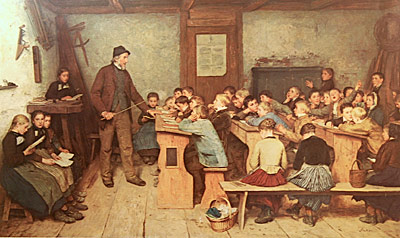
Unit 4: Nationalism, Industrialism, and Imperialism
Lesson H: Social Responses to an Industrialized World
Activity 4: Education Reform
The same factors that influenced socialism to grow in popularity during the 19th century in Europe also contributed to reform efforts in educational systems in industrialized countries. Inequalities between classes, Enlightenment thought, and industrialization greatly contributed to the transformation of education in the Western world.
Directions: Read the following information on education reform, focusing on how and why education systems changed during the 19th century. In the next activity, you will apply what you have learned to analyze images related to education.
The grim and dangerous working conditions of the industrial age caused many in the working class to push for reforms. As early as the 1840s, governments around the Western world passed laws to improve social conditions in response to the demands of their people. For example, in 1847 women and children could not be made to work more than a 10 hour work day. Throughout the century, public health and housing for workers in cities improved, and, by the end of the 19th century, education had transformed in response to the needs of industrialization.
Prior to the reforms of the 19th century, religious institutions were primarily responsible for education. For example, before 1870, the only formal education available for British children was in religious schools and "ragged" schools, which taught poor children basic skills such as reading. Outside of religious schools there were very few education opportunities in general, especially for the lower classes. Many of the early elementary schools found in the countryside were primitive and the teachers themselves had little education. The lower class boys would perhaps instead find apprenticeships and learn a trade; others simply worked whatever jobs available to earn an extra income.
Lower class girls often received no education since it was not seen as necessary for their traditional role in society. On the other hand, upper class families could use tutors and private schools to teach their children the skills and knowledge they felt was necessary.
Two important responses to the Industrial Revolution changed this system. The first was that the working class demanded better living conditions and services, including education. Many pushed for education reform since they saw it as a way for their children to obtain better jobs that could lead to more equality. The second response was that of the upper classes who saw a growing need for the working class to be better educated to enhance the economy. Reformers felt that teaching the basics - reading, writing, math - would produce better citizens and better workers.
By the late 1800s, both groups of reformers persuaded many governments to set up public schools and require basic education for all children. By the end of the 19th century, any child under the age of 10 was required to go to school instead of work. Teachers became trained at specialized schools, increasing the quality of education received. Many schools emphasized skills needed for industrial work, like punctuality, obedience to authority, disciplined work habits, and patriotism.
Secondary schools were also expanding, and taught Greek, Latin, history, and mathematics. However, typically only middle-class families could afford to have their sons attend these schools in the hopes that it would further their advancement in society.
Education for girls was still undervalued, but they, too, were required to attend school under the new education acts. Girls were sent to school primarily to learn basic knowledge and skills that would allow them to marry well and become wives and mothers. So although they were attending school, they did not focus on the same subjects as the boys did.
Colleges and universities experienced reforms during this period as well. Typically, the people who enrolled in these institutions were sons of middle or upper class families since it cost more money. In the past, the curriculum at universities usually focused on ancient history and languages, philosophy, religion, and law. During the 19th century, universities added courses in the sciences, especially chemistry and physics. Inquiry and research was encouraged, rather than just memorization of facts. Engineering schools also developed.
This shows how the Industrial Revolution influenced the reform of higher education too. As industrialism became more and more important to societies, countries wanted citizens who could be innovators and help their industries grow and prosper. By the 1840s, even a few small colleges had opened for women, although opposition to higher education for women would remain strong through the beginning of the 20th century.
Page Notes:
[1] Source: This image from http://commons.wikimedia.org/wiki/File:Anker_Die_Dorfschule_von_1848_1896.jpg is in the public domain.



